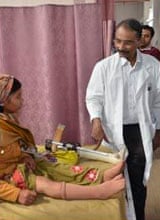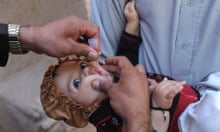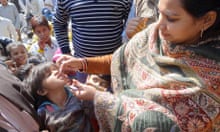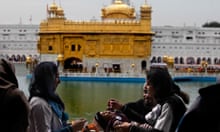
Dr Mathew Varghese, an orthopedic surgeon, runs India's only polio ward, at St Stephen's hospital in Delhi. The ward offers reconstructive surgery, which not only gives patients greater mobility, but also gives them more chance of getting married or finding a job.
Varghese sees approximately 150 polio patients a year. The ward is filled with 20-year-olds who contracted polio in their infancy, but were unaware surgery or other assistance was available. "I dream to see it empty," says Varghese.
That dream may not come true for a while, however. Lack of funding and education remain barriers.
In 1985, India had 150,000 cases of polio. While there have not been any new reported cases in two years, for those who already have the disease, resources are dispersed.
Rotary clubs hold ad-hoc health camps where the needs of polio patients can be assessed. The NGO Jaipur Foot, for example, provides free prosthetics in their clinics, which are scattered through the country. The clinics fit patients with a $45 prosthetic limb, a rudimentary but flexible device designed in partnership with Stanford University. In the US, a similar device would cost around $12,000.
At the Mahavir Seva Sadan in Kolkata, artificial limbs are also distributed for free; since 1985, the institution has reportedly helped more than 140,000 people.
But there is no nationwide programme to connect polio patients with facilities such as St Stephen's hospital or Jaipur Foot. Given that most polio patients need surgery before prosthetics, they tend to find out about free surgery largely through word of mouth.
Manisha, a 20-year-old polio patient at St Stephen's, contracted the disease when she was only 10 months old. She received treatment in February after a family member working at the hospital told her about the surgery.
"I had never heard of the hospital but I'm so glad I found it," she says.
Manisha comes from Aligarh district, less than a two-hour train ride from Delhi. India's national polio plus committee dubbed the area a high-risk zone, where polio was rampant until 2010.
Varghese has seen patients from as far away as Orissa, Uttarakhand and Sikkim. Distance is not the enemy, he says, but "lack of information".
Varghese has met many parents who are concerned their children will not marry because of their disabilities. Madhubala came to him as a teenager. Her parents were worried she would not find a husband because her left leg had been severely affected by polio and she could not work properly.
"Just think, her name is Madhubala, after one of the most beautiful actresses of Indian cinema. But she feels anything but beautiful," says Varghese.
With his help, though, she was able to walk normally. A couple of years after her surgery, she visited the hospital to introduce her husband to Varghese, who travels frequently around the country, training surgeons on how to address conditions such as club foot and polio.
Given the difference surgery can make to people's lives, why does no other hospital in India have a ward devoted to polio patients?
"Polio is not an emergency case. It can wait. That's the mentality at many hospitals," says Varghese. "As it is a poor man's disease, corporate hospitals do not want anything to do with it."
The corrective surgery is free for those who can't afford the $500 fee. It is subsidised by the money made from those who can pay in full for orthopedic surgery. The Patient Welfare Society underwrites the cost of surgery when necessary, while private donors and organisations such as Rotary International have also contributed funds.
Reconstructive surgery has been on offer at St Stephen's since 1987. Since then, more than 7,000 children have been treated. In addition to surgery, the hospital manufactures calipers and braces in-house, to keep costs low.
Seen as a pioneer by the polio community, Varghese says he's merely a "conduit", a tool to help others. His BlackBerry rings constantly. His assistants are repeatedly trying to track him. His next patient is waiting.







